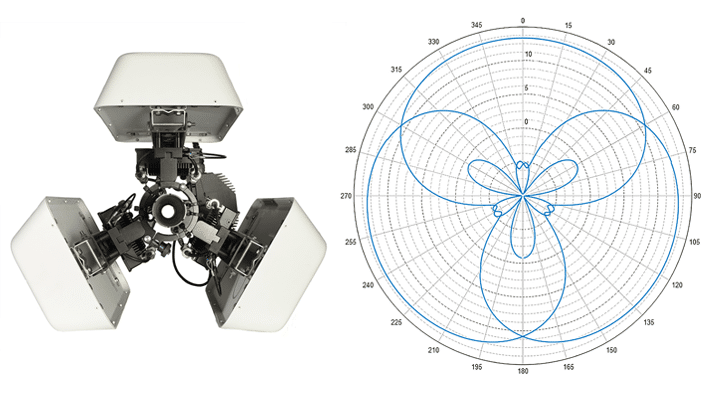Radios & Antennas Working Together To Maximize Tactical Networking Capabilities

Reliable, robust and scalable wireless communications are vital for users who need to stay connected and coordinate actionable intelligence in challenging spectrum environments. Multiple-input, Multiple-output or MIMO radio systems are a key enabler of creating powerful Mobile Ad-hoc Networks (MANET), that provide secure and reliable connectivity across a variety of operational applications. When used in conjunction with MIMO antennas they can be a force multiplier for creating powerful and adaptive mesh networks that unify operational assets in any environment.
This edition of the Waveform Blog provides insights into MIMO-based radio systems and antennas, and how they can be used to create a high-performance tactical communications architecture for today’s mission-critical applications.
The Role and Importance of MIMO Communication Systems
At its core, MIMO communication systems utilize multiple antennas at both the transmitter and receiver ends to send and receive different data streams of a signal simultaneously. By processing signals from multiple paths, MIMO radio systems can mitigate the impact of noise and interference, resulting in vastly improved communication performance over legacy single antenna transceiver systems (SISO).
In addition, with their ability to create multiple parallel data streams that deliver high bandwidth throughput, MIMO communication systems provide users with scalable network connectivity solutions that operate reliably in dynamic and complex RF environments.
With a variety of MIMO radio form factors and MIMO antenna design choices readily available, system operators have integration flexibility options across multiple use cases, with the ability to create custom-tailored solutions to meet their network and mission requirements.
Today, MIMO communication systems deliver increased performance and reliability, making them an essential technology for mission-critical defense, law enforcement, public safety and commercial broadcasting applications.
MIMO Communication Systems Advantages

MIMO communication systems provide significant benefits across multiple use-case applications, making them a preferred choice for organizations deploying reliable communications networks. Some of their critical advantages include:
Increased reliability
Exploiting multiple signal paths makes MIMO-based communication systems more robust, particularly in areas where obstacles, or surfaces that bounce and reflect signals are present. Through the use of spatial diversity, MIMO communications systems can even use the environment to its advantage – leveraging reflections and scattering to enable signals to take multiple paths between the transmitter and receiver. This diversity helps reduce signal fading and improve communication reliability in challenging and dynamically changing environments. The key takeaway is that with MIMO communications systems, users are not required to create unobstructed sightlines for communications – allowing them the freedom and ability to execute missions in complex environments or across multiple domains (land, sea, air).
Enhanced redundancy
With MIMO communication systems, multiple antennas transmit and receive data packets simultaneously. In addition, through the use of Space-Time Coding, the bits of the digitized signal are also coded in time, with redundant bits sent at different intervals to counter-act any time-based variations in the environment. The end result is robustness through redundancy – if you have a packet loss on one data stream, the other streams will compensate, resulting in fewer losses of vital data communications.
Elevated throughput
Through the use of Spatial Multiplexing and Eigen-Beamforming, MIMO communication systems enable users to transmit large amounts of data at high throughput rates. Spatial Multiplexing utilizes multiple antennas to transmit multiple unique information streams. A communications network that features MIMO-based radios and antennas at the transmitter and receiver ends can then decode these streams individually, increasing the amount of data flowing through. Eigen-Beamforming works slightly differently – adjusting the phase and amplitude of the transmitted signal to ensure that the optimal signal is always sent to the receiver. When used together, these two techniques are particularly valuable for high bandwidth operations including real-time video streaming, remote surveillance and other data-intensive applications.
Enhanced visual and auditory quality
A MIMO communications system uses multiple antennas at the transmitter and receiver side to create spatial degrees of freedom. Because of its ability to combine and reconstruct multiple data streams simultaneously, a MIMO communications system can eliminate noise or image corruption – providing users with the highest possible visual and auditory quality.
Expanded flexibility
Because MIMO communication systems for tactical Mobile Ad-hoc Networks are not constrained by fixed infrastructure limitations, they can rapidly be adapted based on changing channel and operational conditions. Communication network operators and RF engineers have multiple choices in the types of MIMO radios and antennas used, enabling them to custom tailor networked solutions based on their operational tempo. By utilizing adaptive signal routing and other advanced MIMO antenna techniques, these systems enable RF signals to navigate complex and multi-path, non-line-of-sight environments, creating a robust and flexible communications network across multi-domain operations (air, land, sea).
MIMO Radio & Antenna Options – An Overview


Typically characterized by its number of antenna ports, MIMO radios come in a variety of form factors ranging from 2×2 MIMO handheld battery-powered radios that can be easily integrated into tactical vests, to externally powered 4×4 MIMO radios that can be temporarily or permanently mounted to vehicles or fixed infrastructure. In addition, each of these radio types typically offers OEM or radio module versions, allowing the physical layer of the radio to be installed and directly connected to manned or unmanned vehicle sub-systems. Because of their bi-directional ability – to both send and receive different data streams simultaneously – MIMO radios excel at delivering high-fidelity video, voice and IP data communications. This translates into a superior radio experience for its operators, providing high bandwidth connectivity coupled with operational flexibility.
MIMO radios are compatible with both Single Input, Single Output (SISO) and MIMO antennas. SISO antennas feature a single port, and rely on the MIMO radio to send, receive and process signals through it. MIMO antennas, on the other hand, contain multiple ports with integrated functional elements that are used to transmit and receive signals simultaneously, thereby optimizing data throughput and enhancing radio connectivity performance. Often in MIMO antennas, their functional elements are polarized opposite of each other for improved signal performance in complex operational environments, with both single and dual frequency band configurations.
Omni Antennas
A SISO antenna type, Omnidirectional antennas radiate equal power in all directions, making them a flexible choice for tactical MANET radio applications. Typically attached directly to the radio or connected via RF cables, Omni antennas provide 360° RF antenna patterns across single or dual frequency bands. Operators can also choose from a range of low to high gain, and horizontal to vertical polarity to customize the performance and RF signature of their communications network.
Panel Antennas
Available in both SISO and MIMO configurations, Panel antennas directionally radiate power, providing improved performance and coverage over focused areas of operation. This high degree of energy and beam focus enables them to overcome environmental obstacles. Panel antennas provide use case flexibility through quick-deploy mast options or fixed installations.
Patch Antennas
A low-profile variant of the panel antenna available in both SISO and MIMO configurations, patch antennas provide a directional RF antenna pattern but with higher gain with a more focused beamwidth than Omnidirectional antennas. With a compact size, patch antennas range from body-worn to mobile/vehicular and installed configurations.
High-Gain Sector Antennas
These MIMO antennas concentrate their signals in a specific area or sector, providing an efficient use of available power and data throughput over extended ranges. To achieve multi-sector coverage, multiple high-gain sector antennas can be combined to create 360° of coverage.
Dish Antennas
These parabolic-shaped MIMO antennas provide high gain and high throughput over long distances. Because they produce the narrowest beamwidth of any antenna type within a focused area of operation, Dish antennas used in wireless communications networks are typically tracking antenna variants, that include automatic azimuth calibration and 360° rotation to maximize their operational effectiveness.
MIMO Communication Systems Applications

MIMO Communication Systems applications are as varied as their form factor options. Their robust network capacity and increased area coverage combined with operational flexibility provide effective connectivity options for tactical to long-range applications.
Defense, law enforcement and public safety
MIMO communication systems are vital in defense, law enforcement and public safety applications, providing secure and reliable network connectivity in complex and austere operational environments. With the ability to unify operational assets including personnel, vehicles, command centers and manned/unmanned aircraft, agencies typically employ a variety of MIMO-based radio and antenna types to create scalable mesh networks that deliver mission success.
Aerospace and aviation
MIMO communications systems enable high-bandwidth data and communications downlink and relays between the aircraft, control center and ground-based personnel. When used together with MIMO technology this results in minimized signal latency and optimized spectral efficiency, ensuring high throughput communication links that are crucial for operational efficiency and safety in congested airspaces.
Unmanned Systems
With their bi-directional ability to both send and receive data streams simultaneously, MIMO communication systems are instrumental in enhancing C2, data downlinks and communication relay capabilities for unmanned systems ranging from stratospheric and high-altitude platform systems (HAPS) and unmanned aerial vehicles (UAV), to unmanned ground vehicles (UGV) and unmanned surface vessels (USV). Given the critical nature of many unmanned missions, secure and EW-resilient communications are essential for mission success. MIMO communication systems provide this operational capability, ensuring robust connectivity and improved situational awareness at greater stand-off range and in contested environments.
Broadcasting and multimedia
MIMO communications systems stand out for their unique spatial multiplexing capabilities, allowing broadcasters to transmit multiple data streams over the same frequency band. This, combined with advanced MIMO radio and antenna techniques paves the way for high-definition signal reception even in congested spectrum environments and complex urban environments with multi-path reflections.
Acting as a force multiplier for operational teams, MIMO communication systems create a powerful MANET mesh network that connects and unifies communications throughout your area of operation – from personnel, vehicles and command posts to long-range unmanned and manned aircraft.

Silvus MIMO Radios
As the world’s leading developer of advanced MIMO communication systems, powered by Silvus’ proprietary MN-MIMO waveform, Silvus Technologies is reshaping mesh network technology for mission-critical applications – on the ground, in the air and at sea. Purpose-built to outmaneuver tactical RF challenges in any environment with class-leading throughput, range, EW resiliency and scalability, our family of StreamCaster MANET radios delivers next-generation capabilities to Defense, Public Safety and Commercial customers around the world. To learn more, visit the StreamCaster Radios page.
StreamCaster Radios
Silvus MIMO Antennas
Silvus’ StreamCaster PRISM family of Precision Integrated Sectorized MIMO antennas is a modular solution that combines the performance of StreamCaster MANET radios with high-gain, dual polarity sector antennas to deliver up to 360° of coverage for tactical to fixed infrastructure applications. To learn more, visit the StreamCaster PRISM page.
StreamCaster PRISM
Silvus StreamCaster TRINITY Dual Band MIMO Transceiver Array delivers high bandwidth, long-range mesh network communications in any environment. Featuring a unique Trilobe design, each of StreamCaster TRINITY’s three, high-gain 12 dbi sector antennas provides 120° of coverage, extending the area of operation for manned/unmanned air and ground assets. Use them independently or together to achieve up to 360° of coverage
StreamCaster Trinity
Your Mission Is Our Mission:
Silvus Technologies is dedicated to one mission: Solving the toughest communication problems on the planet.
Since Silvus’ founding, we’ve pioneered MIMO communication technology, culminating in the release of the world’s first ever tactical MIMO radio. Through groundbreaking research & development, Silvus’ team of top PhD scientists and design engineers continue to innovate MIMO communications for the tactical edge, enabling new capabilities and applications for customers in high-stakes industries.
Through everything we do, we take a partnership approach – bring us your most difficult communication problems and we’ll help you solve them with MIMO communication technologies that just work.
Learn More
Contact Us Today to learn how Silvus is delivering advanced MIMO Communication Systems Technology
for mission critical applications in any operational environment.
Share





















